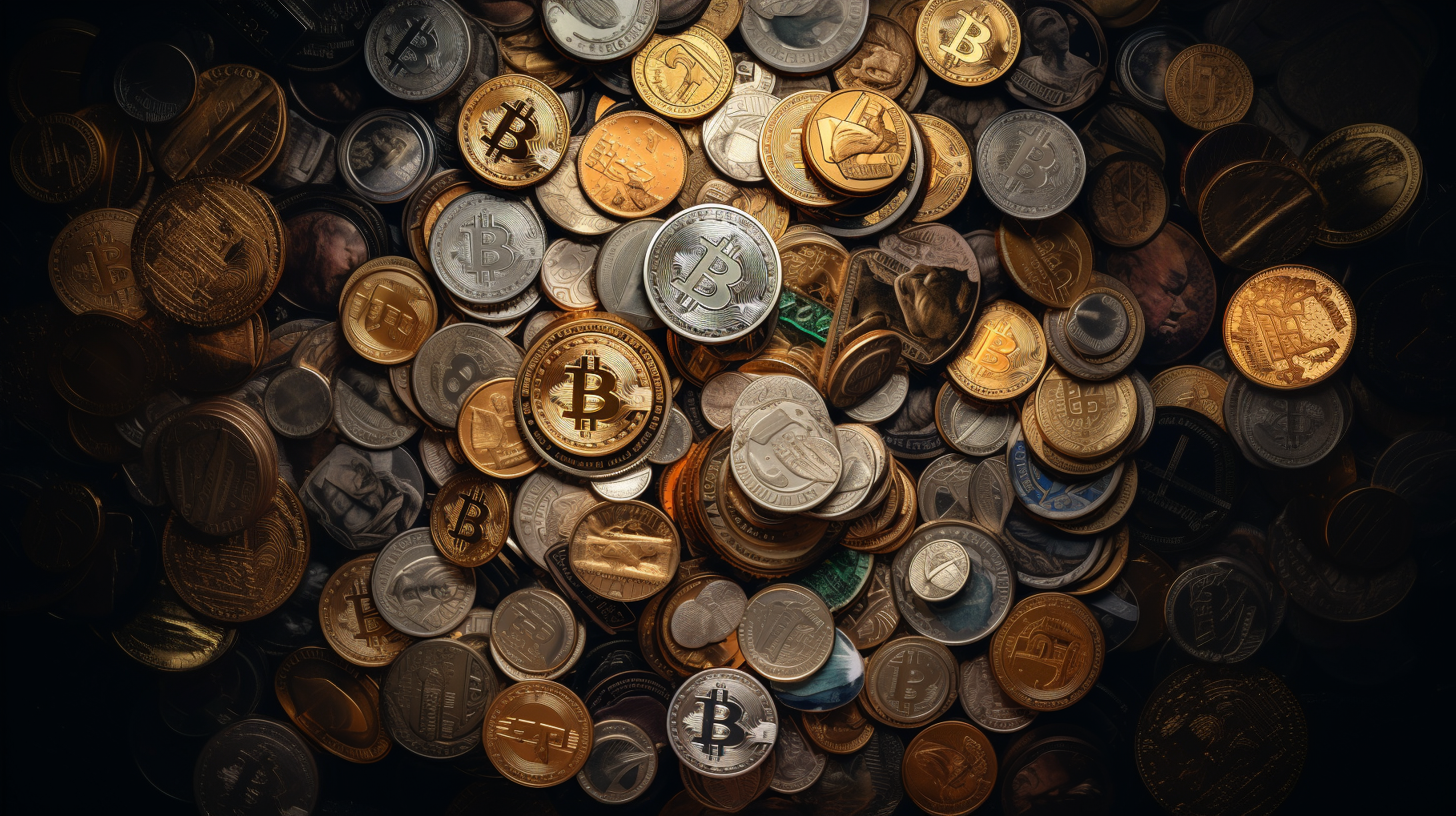
Rising Coin Report – Worldcoin
#HornAndCompany #Blockspace #DigitalAssets #Crypto
“We will no longer be able to distinguish whether we are dealing with the work of a human or a machine”
Have you ever had to consider whether a text, an image, or even the person on the other side of the webcam in the digital world is human or machine? The distinction between human and machine origins has become increasingly difficult, at least on superficial inspection – and increasingly since the enormous rise in popularity of ChatGPT and other generative artificial intelligence. Assuming you continue to consider it important to maintain the distinction between human and machine in the digital world, you will be intrigued by Open AI CEO Sam Altman’s blockchain-based project Worldcoin. After all, the quote introduced above from Alexander Blania, CEO of Tools for Humanity, the company behind Worldcoin, names the latter as the fundamental motivation for Worldcoin [1].
Worldcoin, Sam Altman and Orbs
Now, as a blockchain enthusiast, you may have heard of Worldcoin. Since the launch of Worldcoin on July 24, 2023, this new project by Sam Altman has – unsurprisingly – attracted a lot of attention. Whether justifiably or not, you can hopefully answer for yourself after reading this post. What is certain is that Worldcoin is attracting a lot of public interest for a number of reasons. We think that is foremost due to two very superficial reasons: First, to the involvement of the latest Silicon Valley “wunderkind” Sam Altman, and second, to the verification of “being human” via possibly somewhat dystopian iris scanning devices called “orbs” that are currently being placed in major cities around the world. But beyond these two reasons, which admittedly lend themselves perfectly to initial excitement, there are a number of significant thoughts behind Worldcoin about the relationship between humans and machines and the social order in a world where much of the value creation potentially falls to machines.
Worldcoin‘s digital identity
In Germany, when we think of digital identity, we think of digital ID or digital medical record. Similarly, others may think of digital identities as digital entities that cannot be directly assigned to a human being. In context of our BlockSpace, for example, one might think of Satoshi Nakamoto, inventor of Bitcoin. After all, Satoshi undoubtedly has a specific identity in the Bitcoin blockchain, even if only as a wallet address on the Bitcoin blockchain.
Proof of Personhood
Worldcoin differs fundamentally from both ideas: On the one hand, Worldcoin founders Altman and Blania see the need to bridge the gap between digital and analog worlds. On the other hand, they do not want to rely on borders of continents, governments and states, but claim to have invented a global, government-independent solution in Silicon Valley moonshot style: Supported by aforementioned Orbs, a proprietary technical development equipped with sensor and camera technology that scans the human iris, a person’s uniqueness is confirmed and stored anywhere in the world, of course, if there is access to an Orb. This concept, which does not require much more than technology supplied by Worldcoin and a person who has their iris scanned, is called “Proof of Personhood”, specifically with the aim of proving the existence of a person and translating this into an associated digital identity, the World ID, by means of a hash function applied to the biometric features of the iris.
Easy registration with App and Orb
In practical terms, registration is comparatively simple. The World App can be installed on a smartphone. A World ID is created with a few clicks, which must then be verified at the closest Orb. Once that is done, one receives 25 Worldcoin Tokens (WLD) for new registration, about 30 USD at the time of this article’s publication. WLD is based on the Ethereum-based layer 2 solution Optimism, which also keeps popping up among trending coins on our Horn & Company crypto dashboard [2]. In total, a quantity of 10 billion WLD will be issued. This number is set for a period of 15 years, after which annual inflation of up to 1.5 percent will be possible. Of the tokens, 75 percent will be made available to the community of users, while 13.5 percent will be reserved for Tools for Humanity investors. The original development team will receive 9.8 percent of the tokens, while 1.7 percent will be held in reserve. Interestingly, the hype of Worldcoin in the first weeks of existence, with over 2 million World IDs registered after all, certainly does not seem to translate into a positive price trend: From a price of up to €2.50 for a WLD token on launch day of July 24, the price dropped to about €1.12 for a WLD token. Whether the great public interest in Worldcoin also manifests itself in a positive price development of the WLD token remains open.
From identity to inclusion: How Worldcoin is reshaping financial services
Distribution of WLD tokens to all users of the Worldcoin network may be particularly relevant in the financial industry. In addition to 25 WLD tokens that are awarded upon new registration, Worldcoin plans to pay out tokens to all users on a regular basis. Exactly how much will be paid out depends on various factors, which Worldcoin describes in its own “Tokenomics” [3]. Current scale of variable payout since launch of Worldcoin is still limited with 3 WLD tokens in addition to the 25 WLD tokens for new registration, but we would like to play along with idea of the Worldcoin founders before we also address critical voices. In the long run, Worldcoin is planning to offer a digital basic income in this way. Contrary to initial reflex that such a basic income would contradict the ideals of Silicon Valley, it fits in perfectly with the widespread libertarian school of thought in the valley. Prominent representatives, such as Elon Musk, Mark Zuckerberg, and Sam Altman accept future necessity of a (digital) basic income. However, not in a bureaucratic, government-organized form, but in a global and private form, in which all beneficiaries are provided with the same basic income. It is precisely possible that Worldcoin grants through specific implementation of the Proof of Personhood, which allows global confirmation of individual “personhood” independent of government institutions.
Even if current weekly distributions of about 3 WLD tokens alone do not even lift recipients above the World Bank poverty line (2.15 USD per day [4]), Worldcoin may still have an enormous impact on the financial industry in the long run. From our side, there are two main arguments in favor of this. If distribution of physical orbs works sufficiently well, access to Worldcoin is extremely easy. All it takes is a smartphone and a scan of the iris. This simplicity is already familiar in mobile payments, if one thinks of use of such mobile payment apps versus classic account use, e.g., in Kenya [5]. Worldcoin adds two dimensions of proof of personhood and a digital basic income to this working idea of easily accessible mobile payments. While one may not be able to directly access the Euro or Dollar system via Worldcoin without government-validated identity, there may be a large number of people who were previously cut off from many financial services beyond mobile payment that can now be implemented within a Decentralised Finance (DeFi) system using Worldcoin. Thus, one can imagine an entirely new target group for a wide variety of financial services based on smart contracts.
This idea becomes particularly relevant if Worldcoin takes an overall positive development and weekly distribution of WLD tokens actually come closer to a notion of a basic digital income. If this idea of Sam Altman comes true, Worldcoin will not only have the possibility to offer all people an uncomplicated access to DeFi financial services, but also to provide them with a regular income, which will make the use of these services beyond mobile payments interesting.
Competition, alternatives and what makes Worldcoin different
Worldcoin were not the first to find Proof of Personhood necessary and implement it. Some other companies include Quadrata, Humanbound, Bright ID, Circle, Idena, and Proof of Humanity.
Basically, approaches used by these companies can be divided into two primary methods for establishing personal identity: Graph-based and biometric approaches. The social graph-based method relies on confirmations from individuals within a network. If various participants in a network have all been verified as human and collectively confirm human status of additional participants, it is likely that they are indeed human.
Biometric proof of humanity, on the other hand, is about validating certain physical or behavioral characteristics that distinguish humans from automated bots and even differentiate between individuals. Usually, a combination of these two strategies is used in most projects.
In this dichotomy, Worldcoin can be assigned to biometric verification and, with the introduction of the orb, has created a tool that dispenses entirely with social graphs or networks for verification. The absence of graph-based methods, as well as less secure biometric methods such as certain video formats, can be seen as a strength of Worldcoin over competing models (assuming the distribution of orbs works as intended). In combination with the great interest in the person Sam Altman and the strong connection to the analog world through the actual provision of the orbs, Worldcoin just seems to have the momentum on its side here compared to the alternatives.
Data Protection, transparency, fraud: Critical voices
A central criticism of Worldcoin revolves around data protection and transparency. Although the company assures that each Orb only performs local calculations and that only hashes of the iris scan are stored, concerns still remain. Data protection experts warn against disclosing biometric information. This is because the risks in the event of fraud are far higher with biometric data: unlike a password, it is unchangeable and once in wrong hands may be difficult to recover. This view is also supported by Edward Snowden and organizations such as the Electronic Frontier Foundation. Max Schrems, a prominent EU privacy activist, also expresses concerns. He warns that most startups do not succeed and thus biometric data can comparatively quickly end up in bankruptcy estate of a failed startup [1]. This raises questions beyond Worldcoin about responsibility and security of handling biometric data.
In addition to foreseeable critical voices of data protection experts, there is also criticism from prominent figures in the blockchain scene. Vitalik Buterin, co-founder of Ethereum, also complains that it is not sufficiently transparent what calculations an Orb performs. This lack of transparency also leads him to have justified doubts about how it works and the potential risks. A very practical point of Buterin’s criticism is the lack of geographical spread of orbs so far. Currently, registration is limited to the largest cities in the world, except for a few mobile teams. In Germany, for example, possibility of verification currently only exists in Berlin at Alexanderplatz. Despite all criticism, however, Buterin also has many words of praise for Worldcoin and attests to the fact that Worldcoin has taken the necessary steps to anonymize users, such as the implementation of zero knowledge proof technology to conceal the connection between individual online actions and a specific person [6].
Another critical issue is a possible misuse of World IDs. MIT Technology Review warns of this, fearing that technology could be used to pass off machines as human users in order to facilitate fraud attempts: Once the World ID is verified, the login works without further verification and can thus be easily traded. At the same time, logins are currently already being traded in states where Worldcoin is not yet available for regulatory reasons. While any World ID can be reset via re-verification at an Orb, damage may have already been done in interim state. Specifically, it is also reported that Orbs worldwide are mainly maintained by volunteers who have a financial interest in registering as many users as possible. This leads to the fact that the education about the technological backgrounds can come too briefly opposite the registrants.
Finally, we would like to raise a fundamental point of criticism that is discussed time and again. This is because the question of whether it is a good idea to trade privacy, or in this case biometric data, for a financial incentive needs to be debated once again. To some, this practice may seem like a logical consequence of the data economy, in which many of us share our data with the big technology corporations from the US in order to take advantage of often very good services that are also “free” when trading these services for user data. To what extent this applies to biometric data and proof of personhood is a question that everyone will have to answer for themselves.
Conclusion: Navigating Worldcoin‘s path forward
The necessary distinction between human and machine in the digital world has been recognized. Worldcoin, with its prominent supporters, is pursuing the unique goal here of using a biometric iris scan and orbs designed and built exclusively for this purpose to verify the identities of people worldwide and create digital identities. In the long term, Worldcoin aims to offer a basic digital income by regularly distributing tokens to users. We see potential in smart contract-based financial services especially in equally easy access worldwide and in connection to DeFi ecosystems in combination with a digital basic income. It remains to be seen whether Worldcoin will prevail against the justified concerns of both data protection experts and crypto pioneers like Vitalik Buterin. This much is certain: We will be happy to keep you up to date on financial service related crypto developments on our Blockspace.
Sources:
[1] Worldcoin: Sam Altmans bizarre Pläne für eine Krypto-Weltwährung (nzz.ch)
[2] https://www.horn-company.de/blog/crypto/h-und-c-dashboard-bietet-uebersicht-im-krypto-dschungel/
[3] https://whitepaper.worldcoin.org/tokenomics#user-grants-target-allocation-60
[5] https://www.sueddeutsche.de/wirtschaft/handy-statt-konto-wofuer-denn-banken-1.3801454
[6] https://vitalik.eth.limo/general/2023/07/24/biometric.html


